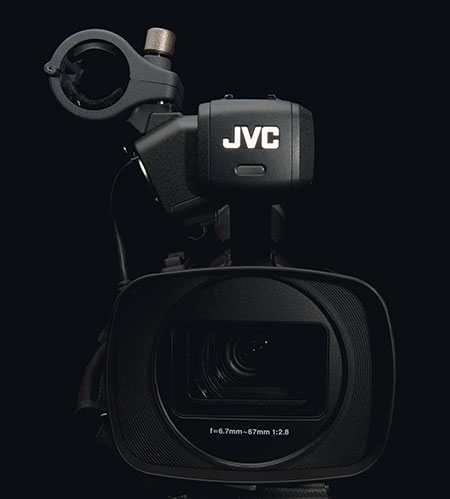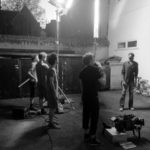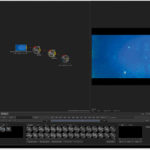
Review – JVC GY-HMQ10E 4K CAMCORDER
Posted on Nov 9, 2012 by Alex Fice
JVC’s new 4K camera. All pics © Adam Garstone.
ADAM GARSTONE reviews the new 4K camcorder from JVC who know a thing or two about presenting the latest technology in a value for money package – they did the same with HDV over seven years ago
In late 2005, we reported on a JVC innovation that was to change the world of High Definition video capture. JVC had come up with technology that massively reduced the cost, and the size of HD camcorders. Although regarded with suspicion by many HD pioneers – the image quality wasn’t, perhaps, of the highest standard – this new technology, HDV, went on to bring High Definition video to… well, you don’t need me to tell you how important HDV became.
JVC’s latest innovation is a 4k camcorder in a body significantly smaller than a PD150. If that sounds like a toy to you (and, I’ll admit, it did to me when I first heard about it at NAB) then just think back to that first JVC HDV camcorder – a ‘toy’ that started a revolution.
The GY-HMQ10E (even the name harks back to the HDV JY-HD10) is a fixed lens, single CMOS sensor camcorder, recording 3840 x 2160 images onto four SDHC cards simultaneously. JVC provide a free Mac application that will stitch these four streams back together into a ProRes file – it’s not a fast process, but it works. The sensor is 1/2.3” and back-illuminated, and sits behind a 10x zoom lens with a range of 42.5mm to 425mm (35mm equivalent). There is a wide angle adapter available as an optional accessory (actually, JVC’s website mistakenly calls it a wide angel adapter!).
The recording data rate is 144Mbits/s (VBR) using H.264 (MP4) at the rather odd frame rates of 60p, 50p or 24p. You can also record 1080p/i at these same frame rates, using 36Mbits/s AVCHD – this mode only uses a single SD card, so no need for the stitching software. Interestingly, there are also four mini-HDMI connectors on the side of the camera. In parallel, these output live, un-compressed 4k, if you can find anything that will record the four streams.
 Standard offering for the JVC but with slightly fiddly controls.
Standard offering for the JVC but with slightly fiddly controls.
This left side of the camera has the traditional Gain and White Balance switches, and slightly fiddly controls for Iris, Shutter, Manual/Auto focus, Full Auto and Auto Exposure compensation. The focus control is a continuous encoder ring around the lens, and the iris/shutter control is a little thumbwheel, which is also used for inputting numerical values in the user interface. The lens aperture is f/2.8 wide open (dropping to f/4.5 at the long end of the zoom), and only closes down to f/5.6. In many ways, this is a good thing, as the small sensor will start to show resolution degradation due to diffraction effects at smaller apertures, but the camera doesn’t feature any built-in ND filters, so controlling exposure is a bit tricky. You end up increasing shutter speed which (obviously) introduces motion artefacts. Fortunately, there are two, threaded filter rings (one on the lens, one on the hood), so you could attach external ND filters without going the whole matte-box hog.
Under the 3.5”, flip-out LCD are some user programmable buttons – by default they are assigned to focus assist, macro and zebra. It’s a shame that there isn’t a dedicated focus assist button in a more appropriate place. The JVC’s focus assist is a type of peaking, where the viewfinder becomes black and white with focussed edges getting a coloured highlight. It works very well – vital, of course, for a 4k camera. Having said that, the autofocus is surprisingly fast and accurate too, though low light, or low contrast subjects tend to slow it down, and focus sometimes breathes in these conditions.
 The sensor is 1/2.3” and back-illuminated, and sits behind a 10x zoom lens with a range of 42.5mm to 425mm.
The sensor is 1/2.3” and back-illuminated, and sits behind a 10x zoom lens with a range of 42.5mm to 425mm.
The LCD viewfinder is pretty good, with a resolution of 920,000 pixels, though it’s very reflective and difficult to see in bright light. It’s a touchscreen, and the only way of accessing the user interface menu, so fixing a hood over it improves the view, but makes it hard to drive the camera. The UI is all new for this camera, and is very straightforward and simple to use, though the touchscreen itself can be frustratingly unresponsive. The camera also takes a very long time to boot up. There is an eye-level viewfinder on the top, rear of the camera but it’s probably the worst EVF I have ever come across, low resolution (260,000) with terrible optical distortion (spherical and chromatic) and internal reflections in the optics.
The other camera controls are very much as you would expect and the camera feels nicely weighted in the hand, with a smooth zoom rocker. There is a built-in stereo microphone above the lens, and a detachable handle has a shotgun mount and two XLR inputs with all the usual controls. No shotgun mic is supplied. If you have the handle attached, the only way to go back to using the built-in mics is to physically unplug the cable – not the neatest solution and, personally, I like a record button on the handle of a camcorder and there isn’t one, but you can’t have everything.
What you do get, though, is pretty amazing image quality. MTF50 resolution was 900-1100 LW/PH (dropping off a bit at the long end of the lens) which compares favourably with other fixed lens camcorders (for example, Sony’s EX1) and far better than I was expecting for a 4k camera in this price bracket. There were tiny compression artefacts around high contrast edges, and some chromatic aberration, but neither was distracting, or even particularly noticeable unless you went looking for them. Shadow detail ultimately gets lost in the compression mush, but it’s surprising how much you can recover in the grade. Like most video cameras, however, you have to be careful of highlights – detail lost here is gone forever. The camera is very contrasty, although there are gamma controls to help here, and I would always leave the camera set on the softest gamma – on a bright, sunny day you’ll struggle to hold both sky and shadow detail. Colours are rendered well, but if you turn up the gain in low light, the pictures get pretty noisy – remember that this is a small sensor with 8.3 million pixels crammed onto it. That also makes it less sensitive than its 1080p competitors – perhaps that explains the lack of ND filters – it has to be very bright before you overwhelm the sensor.
The lens features Optical Image Stabilisation, though it doesn’t seem to perform nearly as well as the latest from Sony, Panasonic or Canon, which is a shame. Camera shake quickly reduces the apparent resolution of a 4k camera, and the lightweight, camcorder format lends itself far more to run-and-gun than tripod use. Perhaps another victim of the low price point of the camera? Fortunately, overall build quality doesn’t seem to have been sacrificed – the HMQ10 is plastic bodied and light, but is solid enough. There is no battery charger supplied – you have to charge the battery on-camera – so, practically speaking, you would need to buy a charger as well as spare batteries.
A further annoyance, from a post-production point of view, is that the camera doesn’t support any kind of timecode. Whilst DSLR users are used to this, the NLE plug-ins supplied for these cameras usually generate timecode of some sort (often using the creation time of the file, or just 00:00:00:00). JVC’s software doesn’t do this, which can cause real problems further down the line. Not an insurmountable problem, but a pain.
 3840 x 2160 images are recorded onto four SDHC cards simultaneously and then stitched back together.
3840 x 2160 images are recorded onto four SDHC cards simultaneously and then stitched back together.
The JVC HMQ10 isn’t a perfect camera. The eye-level viewfinder is horrid, the touch screen UI is unresponsive and some of the controls are fiddly. That said, the camera performs very well in ‘full auto’, it’s small (ish), cheap (for a 4k camera – about £3350 plus VAT) and the image quality is much better than I expected.
4k acquisition, outside of feature film production, is an unknown market – but then almost no-one had an HD TV when JVC launched HDV back in 2005 and look where we are now. JVC intends to bring 4k to the masses, and you can be sure that the other mainstream manufacturers will be right there too which, like its HDV predecessor, makes the HMQ10 a camera that’s difficult to ignore.








